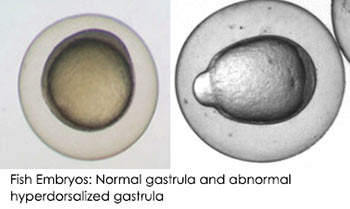 The BML Toxicology Laboratory (G.N. Cherr, Principle Investigator) has focused extensively on Pacific herring in San Francisco Bay in that they are key to the San Francisco Bay ecosystem and represent the last commercial fishery inside of the Bay. The BML Toxicology Group was the first to demonstrate that creosote-treated pier pilings (and the soluble polycyclic aromatic hydrocarbons; PAHs) present a danger to herring embryos when eggs are spawned directly on the piling surfaces. This research was utilized by the State of California in the decision to ban the use of any new creosote-treated pilings in waters of the State. In 2007, the BML group was approached by California State (Dept. of Fish and Wildlife) and Federal (NOAA) Trustees to collaboratively conduct the Natural Resources Damage Assessment for the Cosco Busan fuel oil spill in San Francisco Bay. Results from these field-based studies were remarkable in that unexpected high mortalities with complete cytolysis of embryos were observed at lightly oiled sites where herring had spawned in the intertidal zone. No significant mortalities were observed at non-oiled reference sites at the same tidal height. Furthermore, embryos outplanted at depth without sunlight exposure at the same oiled sites showed classic oil-related cardiac abnormalities but no cytolysis and mortality. These findings led to the conclusion that sunlight combined with the fuel oil to result in dramatic phototoxicity and this was published in the Proceedings of the National Academy of Sciences USA. A follow-up study investigated the direct role of sunlight in bunker fuel oil phototoxicity and was published in PLoS ONE. This study demonstrated that phototoxicity of bunker fuel was much greater than Alaska North Slope crude oil and that the phototoxicity was probably due to compounds in bunker fuel other than PAHs.
The BML Toxicology Laboratory (G.N. Cherr, Principle Investigator) has focused extensively on Pacific herring in San Francisco Bay in that they are key to the San Francisco Bay ecosystem and represent the last commercial fishery inside of the Bay. The BML Toxicology Group was the first to demonstrate that creosote-treated pier pilings (and the soluble polycyclic aromatic hydrocarbons; PAHs) present a danger to herring embryos when eggs are spawned directly on the piling surfaces. This research was utilized by the State of California in the decision to ban the use of any new creosote-treated pilings in waters of the State. In 2007, the BML group was approached by California State (Dept. of Fish and Wildlife) and Federal (NOAA) Trustees to collaboratively conduct the Natural Resources Damage Assessment for the Cosco Busan fuel oil spill in San Francisco Bay. Results from these field-based studies were remarkable in that unexpected high mortalities with complete cytolysis of embryos were observed at lightly oiled sites where herring had spawned in the intertidal zone. No significant mortalities were observed at non-oiled reference sites at the same tidal height. Furthermore, embryos outplanted at depth without sunlight exposure at the same oiled sites showed classic oil-related cardiac abnormalities but no cytolysis and mortality. These findings led to the conclusion that sunlight combined with the fuel oil to result in dramatic phototoxicity and this was published in the Proceedings of the National Academy of Sciences USA. A follow-up study investigated the direct role of sunlight in bunker fuel oil phototoxicity and was published in PLoS ONE. This study demonstrated that phototoxicity of bunker fuel was much greater than Alaska North Slope crude oil and that the phototoxicity was probably due to compounds in bunker fuel other than PAHs.
 In related research, the BML Toxicology Laboratory has investigated the effects of environmental contaminants that impair early development in invertebrates as well as lower vertebrates. Using the sea urchin embryo model system, they were the first group to demonstrate that individual PAHs and water-soluble creosote compounds disrupt the establishment of the embryonic axis. Establishment of the embryonic axis is highly conserved across phyla (worms to humans) and the Wnt/ß-catenin signaling pathway is responsible. The research demonstrating that PAHs can disrupt this pathway and cause nuclear ß-catenin accumulation is a newly described mechanisms of PAH toxicity and alters embryonic axis determination in a vertebrate system (zebrafish) as well.
In related research, the BML Toxicology Laboratory has investigated the effects of environmental contaminants that impair early development in invertebrates as well as lower vertebrates. Using the sea urchin embryo model system, they were the first group to demonstrate that individual PAHs and water-soluble creosote compounds disrupt the establishment of the embryonic axis. Establishment of the embryonic axis is highly conserved across phyla (worms to humans) and the Wnt/ß-catenin signaling pathway is responsible. The research demonstrating that PAHs can disrupt this pathway and cause nuclear ß-catenin accumulation is a newly described mechanisms of PAH toxicity and alters embryonic axis determination in a vertebrate system (zebrafish) as well.

